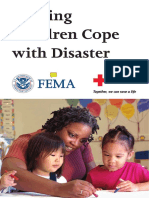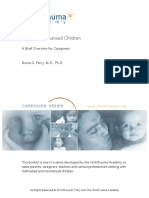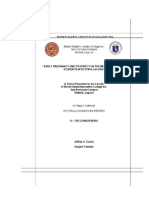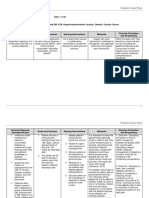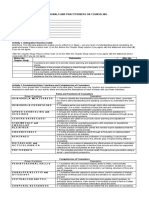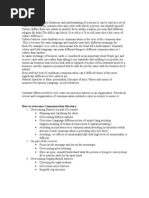Understanding The Impact of Disasters On The Lives of Children and Youth
Understanding The Impact of Disasters On The Lives of Children and Youth
Uploaded by
Wowo Masthuro MahfudCopyright:
Available Formats
Understanding The Impact of Disasters On The Lives of Children and Youth
Understanding The Impact of Disasters On The Lives of Children and Youth
Uploaded by
Wowo Masthuro MahfudOriginal Description:
Original Title
Copyright
Available Formats
Share this document
Did you find this document useful?
Is this content inappropriate?
Copyright:
Available Formats
Understanding The Impact of Disasters On The Lives of Children and Youth
Understanding The Impact of Disasters On The Lives of Children and Youth
Uploaded by
Wowo Masthuro MahfudCopyright:
Available Formats
Cooperative Extension
Understanding the Impact of Disasters on the Lives of
Children and Youth
Promoting the Health and Well-Being of Families During Difcult Times
Lynne M. Borden, Extension Specialist and Associate Professor
The University of Arizona Norton School of Family and Consumer Sciences
The purpose of this fact sheet is to offer parents and
others who work with children and youth an understanding of the impact of a natural disaster, such as a
drought, on the lives of young people. As discussed in
the Supporting Families Following a Disaster introductory fact sheet, disasters can be immediate, as with a
tornado, or long-term as with the effects of a drought.
Disasters can also be natural weather-related disasters or human-made disasters such as airplane crashes, or the collapse of bridges or building. This fact
sheet offers both parents and others information that
can be used to rst understand the effect of stress on
the lives of young people and then to provide ways to
support them during difcult times.
How Do Disasters Affect Young People?
Disasters, whether natural or human-made, often
leave todays families facing difcult times due to loss
of parental employment, relocation, divorce, death of
a family member and other catastrophic events that
create stress for all members of the family. For example, ranching and farming families nd their lives
greatly inuenced by weather-related events such as
oods, res, droughts and blizzards. These events
can often cause short-term disruptions within the
family or they can be long-term and change the lives
of family members dramatically. As noted in one of
the other Fact Sheets in this series entitled, Promoting
the Health and Well Being of Families During Difcult
Times: Supporting Families Following a Disaster, it is the
severity of the experience that is related to overall
levels of ill-effects (Yule, 1993) for the family members involved. Understanding the emotional reactions of children and young people to a disaster such
as a re, drought, or hurricane is important when trying to provide support. The American Academy of
Pediatrics Work Group on Disasters (1995) suggests
that young people experience disasters depending on
several factors:
Proximity to the impact zone;
Awareness of the disaster;
Physical injury sustained;
Amount of disability;
Witnessing of injury or death of family member or friend;
Perceived or actual life threat;
Duration of life disruptions;
Family and personal property loss;
Parental reactions and extent of familial disruption;
Childs pre-disaster state; and
Probability of recurrence.
The American Academy of Pediatrics Work Group on
Disasters (1995) further suggests that there are ve
primary responses seen in children resulting from
loss, exposure to trauma, and disruption of routine:
Increased dependency on parents or guard
ians;
Nightmares;
Regression in developmental achievements;
10/2004
AZ1341C
THE UNIVERSITY OF ARIZONA
COLLEGE OF AGRICULTURE AND LIFE SCIENCES
TUCSON, ARIZONA 85721
LYNNE M. BORDEN
Extension Specialist and
Associate Professor
Norton School of Family and Consumer Sciences
This information has been reviewed by university faculty.
ag.arizona.edu/pubs/health/az1341C.pdf
Issued in furtherance of Cooperative Extension work, acts of May 8 and June 30, 1914, in cooperation with the U.S. Department of Agriculture,
James A. Christenson, Director, Cooperative Extension, College of Agriculture and Life Sciences, The University of Arizona.
The University of Arizona College of Agriculture and Life Sciences is an equal opportunity employer authorized to provide research, educational
information, and other services only to individuals and institutions that function without regard to sex, religion, color, national origin, age,
Vietnam era Veterans status, or disability.
Specic fears about reminders of the disasters; and
Demonstration of the disaster via posttraumatic play and reenactments.
Interpersonal difculties; and
Posttraumatic stress disorder.
Adolescents
The Work Group also identied possible responses of
children and young people by specic age groups.
Decreased interest in social activities, peers,
hobbies, school;
Toddlers and Preschoolers
Anhedonia (an inability to experience pleasure);
Reaction reects that of parents;
Decline in responsible behaviors;
Regressive behaviors (e.g., returned to thumb
sucking);
Rebellion, behavior problems;
Decreased appetite;
Vomiting, constipation, diarrhea;
Sleep disorders (insomnia, nightmares);
Tics, stuttering, muteness;
Clinging;
Reenactment via play;
Exaggerated startle response;
Irritability; and
Posttraumatic stress disorder.
School-Age Children
Stronger effects than other age-groups;
Fear, anxiety;
Increased hostility with siblings;
Physical complaints;
Sleep disorders;
School problems;
Social withdrawal;
Reenactment via play;
Apathy;
Posttraumatic stress disorder; and
Decreased interest in peers, hobbies, school.
Preadolescents
Increased hostility with siblings;
Physical complaints;
Eating disorders;
Sleep disorders;
Eating disorders;
Change in physical activities;
Confusion;
Lack of concentration;
Risk-taking behaviors; and
Posttraumatic stress disorder
The after-effects of a disaster can clearly disrupt the
lives of children and young people, as illustrated by
the above lists of possible responses by age group.
The disruptions and the accumulation of stressors
that occur in their lives due to the disaster, regardless
of type or duration of the disaster, are what determine
the level of negative effects in the lives of children.
When to Get Help
The lists above provide an overview of many typical
responses to stress. However there are times when
responses become more intense. Children and young
people should be referred to a mental health professional for evaluation if:
Symptoms signal a very unusual change in
behavior or appearance and persist for more
than 2 weeks;
Several different kinds of symptoms
are seen (e.g., appears sad, complains of head
aches, and sleeps in class);
Symptoms are seen in different settings
(e.g., in different classes, outside of school, at
home, with peers);
Sleep disorders;
The child threatens or actually tries to harm
him or herself or
Decreased interest in peers, hobbies, school;
The child shows signs of abuse or neglect.
Rebellion;
Refusal to do chores;
Physical complaints;
The University of Arizona Cooperative Extension
It is important to note that a disaster, no matter the
type or duration, can dramatically inuence the lives
of all members of the family, even those who may
seem too young to worry or notice. In fact, children
and young people often nd that their own lives
have changed dramatically. For example, they may
not have the same level of parental support available to them, as their parents are often less available
both physically and emotionally due to their need to
cope with the disaster. Further, the roles and routines
within the family may no longer be the same. Mothers may have to return to work, families may have to
relocate, familiar items and places may no longer be
available, and family nances may change dramatically.
These changes present a challenge for the children
and young people within the family, as there is often
a sense of lost reliability, cohesion, and predictability
that can be distressing to children and youth. Understanding a childs possible reaction to stress created
by a disaster is the rst step in providing support
both within the family and, in certain cases, the support of mental health providers.
Internet Resources
Childrens Anger and Tantrums Fact Sheet: Childrens anger fact sheet includes causes of anger and
management tips for parents. http://www.ext.colostate.edu/pubs/consumer/10248.html
Talking to Children about Tough Times, such as
Natural Disasters: What to say in differential age
sensitive ways. http://www.ext.nodak.edu/extpubs/yf/famsci/fs546w.htm
Coping with Traumatic Events: This website, sponsored by the U.S. Department of Health and Human
Services, offers information for parents, teachers, and
special populations on how to work with children and
families during these difcult times. http://www.
mentalhealth.samhsa.gov/cmhs/managinganxiety/
tips.asp
Supporting Families Following a Disaster: The University of Arizona College of Agriculture and Life Sciences Cooperative Extension has designed this series
of fact sheets covering special needs of families during difcult times. http://ag.arizona.edu/fcs/supporting_families/
References
American Academy of Pediatrics Work Group on Disasters. (1995). Psychological Issues for Children in Disasters: A Guide for the Primary Care Physician. Washington D. C.: National Mental Health Services Exchange
Network.
Ebata, A. T., Borden, L. M. (1995). Children, stress and
natural disasters: A guide for teachers and school activities
for children. Champaign-Urbana, IL: University of Illinois.
Saylor, D. F. (1993). Children and disasters. New York,
NY: Plenum Press.
La Greca, A. M., Silverman, W. K. , Vernberg, E. M. &
Roberts, M. C. (2002). Helping children cope with disasters and terrorism. Washington, D. C.: American
Youth and Suicide Fact Sheet: Fact sheet on youth
and suicide; includes statistics, myths and facts about
suicide, risk factors for suicide, guidelines on how
to help suicidal youth, and warning signs to look
for. http://www.ext.colostate.edu/pubs/consumer/10213.html
Any products, services, or organizations that are mentioned, shown, or indirectly implied in this publication do not
imply endorsement by The University of Arizona.
The University of Arizona Cooperative Extension
You might also like
- Principles of Trauma Therapy A Guide To Symptoms, Evaluation, and Treatment 2nd Edition TextbookDocument14 pagesPrinciples of Trauma Therapy A Guide To Symptoms, Evaluation, and Treatment 2nd Edition Textbookwahoy42190100% (1)
- Get Male Crime and Deviance Exploring Its Causes Dynamics and Nature 1st Edition Ronald B. Flowers Free All ChaptersDocument84 pagesGet Male Crime and Deviance Exploring Its Causes Dynamics and Nature 1st Edition Ronald B. Flowers Free All Chaptersgobenilumia100% (5)
- The Supportive Classroom: Trauma-Sensitive Strategies for Fostering Resilience and Creating a Safe, Compassionate Environment for All StudentsFrom EverandThe Supportive Classroom: Trauma-Sensitive Strategies for Fostering Resilience and Creating a Safe, Compassionate Environment for All StudentsNo ratings yet
- Age Related Reactions To Traumatic EventsDocument2 pagesAge Related Reactions To Traumatic EventsVeronica HernandezNo ratings yet
- 3.2 Effects of Disasters On One's LifeDocument2 pages3.2 Effects of Disasters On One's LifeCharmine MendezNo ratings yet
- Module 1 Young Children and Trauma PowerPointDocument51 pagesModule 1 Young Children and Trauma PowerPointArthur100% (1)
- A.3 Risk Factors Underlying DisastersDocument22 pagesA.3 Risk Factors Underlying DisastersMA. HAZEL TEOLOGONo ratings yet
- Earthquake CaregiverDocument6 pagesEarthquake CaregiverSarah Zorica MiticNo ratings yet
- The Life Cycle and DisabilityDocument16 pagesThe Life Cycle and DisabilityJeanYanNo ratings yet
- Family Resilience and Traumatic Stress: A Guide For Mental Health ProvidersDocument5 pagesFamily Resilience and Traumatic Stress: A Guide For Mental Health ProvidersNaila Aliya MarhamaNo ratings yet
- 3. Factors Underlying DisastersDocument26 pages3. Factors Underlying Disastersclaresssatchi18No ratings yet
- From SAMHSA ResilienceDocument11 pagesFrom SAMHSA ResilienceiacbermudaNo ratings yet
- Death and Grief:: Supporting Children and YouthDocument3 pagesDeath and Grief:: Supporting Children and Youthapi-83101465No ratings yet
- Water and FooterDocument11 pagesWater and FooterSen SokhaNo ratings yet
- C. Teacher Guidelines For Crisis Response (A Practical Guide For Crisis Response in Our Schools)Document6 pagesC. Teacher Guidelines For Crisis Response (A Practical Guide For Crisis Response in Our Schools)Wahyu AnggraeniNo ratings yet
- ChildrenDocument12 pagesChildrenapi-309082881No ratings yet
- DRRR W2 - Risk Factors Underlying DisasterDocument41 pagesDRRR W2 - Risk Factors Underlying DisasterMoxyNo ratings yet
- DRRR Module 2Document24 pagesDRRR Module 2RomeoNo ratings yet
- Helping Children Cope With Disaster: A Child's Reaction To Disaster by AgeDocument4 pagesHelping Children Cope With Disaster: A Child's Reaction To Disaster by AgeIvan BodnaryukNo ratings yet
- ENVI PSY Research PaperDocument6 pagesENVI PSY Research PaperQuinnNo ratings yet
- Se14Childhood Trauma & Its Effect On Healthy DevelopmentDocument9 pagesSe14Childhood Trauma & Its Effect On Healthy DevelopmentDwi Ayu OktavianiNo ratings yet
- What Is Domestic ViolenceDocument3 pagesWhat Is Domestic ViolenceAugustoNo ratings yet
- TraumamoduleDocument14 pagesTraumamoduleapi-237959072No ratings yet
- Running Head: PARENTAL ROLES 1Document11 pagesRunning Head: PARENTAL ROLES 1qwertyNo ratings yet
- How to Overcome Your Childhood: Overcome Childhood Trauma, Childhood Emotional Neglect, and Live a Life of FulfilmentFrom EverandHow to Overcome Your Childhood: Overcome Childhood Trauma, Childhood Emotional Neglect, and Live a Life of FulfilmentNo ratings yet
- Following A DisasterDocument6 pagesFollowing A DisasterJulie Ann SalamatinNo ratings yet
- Helping Children and Adolescents Cope With Violent and Disorders: What Rescue Workers Can DoDocument20 pagesHelping Children and Adolescents Cope With Violent and Disorders: What Rescue Workers Can DoIntellibrainNo ratings yet
- Concepts For Understanding Traumatic Stress Responses in Children and FamiliesDocument8 pagesConcepts For Understanding Traumatic Stress Responses in Children and FamiliesELLENA SANTOSNo ratings yet
- Supporting Students After A DisasterDocument29 pagesSupporting Students After A DisasterALDRIN OBIASNo ratings yet
- Helping Traumatized Children: A Brief Overview For Caregivers Bruce D. Perry, M.D., PH.DDocument17 pagesHelping Traumatized Children: A Brief Overview For Caregivers Bruce D. Perry, M.D., PH.DhanabbecharaNo ratings yet
- Trauma and Adverse Childhood Experiences (Aces) : The Impact of TraumaDocument2 pagesTrauma and Adverse Childhood Experiences (Aces) : The Impact of TraumaInfante SanndyNo ratings yet
- How To Implement Trauma-CareDocument14 pagesHow To Implement Trauma-CareGeorgette EliasNo ratings yet
- Abused and Neglected Children FdneDocument26 pagesAbused and Neglected Children FdneRonit ChandNo ratings yet
- AceDocument41 pagesAceapi-434818140100% (1)
- Midwest FloodsDocument9 pagesMidwest FloodsTova GeografNo ratings yet
- Crisis Intervention 2002AGuideforSchoolBasedCliniciansDocument15 pagesCrisis Intervention 2002AGuideforSchoolBasedCliniciansmargaridasolizNo ratings yet
- Children and Climate Change, Disaster, Physical Impact and VulnerabilityDocument42 pagesChildren and Climate Change, Disaster, Physical Impact and VulnerabilityALI AHAMMEDNo ratings yet
- Understanding The Psychosocial Impact of Disasters With LectureDocument25 pagesUnderstanding The Psychosocial Impact of Disasters With LectureArvie ReyesNo ratings yet
- A Guide To Addressing Traumatic Events at SchoolDocument16 pagesA Guide To Addressing Traumatic Events at Schoolapi-284383122No ratings yet
- Learners With Chronic Illnesses Difficult CircumstancesDocument4 pagesLearners With Chronic Illnesses Difficult CircumstancesSharon RoseteNo ratings yet
- Chap 3Document6 pagesChap 3Larry QuiambaoNo ratings yet
- Trauma & Healing-Note-To-Parents & CaregiversDocument13 pagesTrauma & Healing-Note-To-Parents & CaregiversLaura GonzalezNo ratings yet
- GriefDocument3 pagesGriefMirageNo ratings yet
- Aboriginal 2020-Milroy-Healing-Foundation-Young-People-fact-sheetDocument5 pagesAboriginal 2020-Milroy-Healing-Foundation-Young-People-fact-sheetYaro StarakNo ratings yet
- Helping Children and Adolescents Cope With Violence and Disasters For Parents of Children Exposed To Violence or DisasterDocument10 pagesHelping Children and Adolescents Cope With Violence and Disasters For Parents of Children Exposed To Violence or DisasterJuan MurilloNo ratings yet
- GriefDocument4 pagesGriefapi-83101465No ratings yet
- Pass 3Document7 pagesPass 3Benedict TenorioNo ratings yet
- Chapter17 - Child and Adolescent Psychiatry InterventionsDocument26 pagesChapter17 - Child and Adolescent Psychiatry InterventionsteddyskinnerNo ratings yet
- Self CarDocument36 pagesSelf CarJun Vincent AbaoNo ratings yet
- Child and AdolescentsDocument5 pagesChild and AdolescentsEugen TerseNo ratings yet
- Deprem Sonrası Çocuklara Yardım Için Ebeveyn YönergeleriDocument3 pagesDeprem Sonrası Çocuklara Yardım Için Ebeveyn Yönergelerihsinan sinanNo ratings yet
- Early Pregnancy and Its Effect On The Mental Health of Students in Victoria Laguna"Document14 pagesEarly Pregnancy and Its Effect On The Mental Health of Students in Victoria Laguna"Gina HerraduraNo ratings yet
- BullyingtipsheetDocument4 pagesBullyingtipsheetapi-436557162No ratings yet
- Brief Information On Childhood Traumatic GriefDocument2 pagesBrief Information On Childhood Traumatic GriefjuancbarNo ratings yet
- Child AbuseDocument4 pagesChild AbuseGerry Pingen100% (1)
- Cultural and Societal Influences On Adolescent Development and Normal Challenges and Strategies ModuleDocument15 pagesCultural and Societal Influences On Adolescent Development and Normal Challenges and Strategies ModuleMary Grace Jimenez100% (1)
- Family in Health and DiseaseDocument17 pagesFamily in Health and Diseaseabu saniNo ratings yet
- Kochhar Bryant Effective Collaboration For Educating The Whole Child Ch1Document34 pagesKochhar Bryant Effective Collaboration For Educating The Whole Child Ch1Michael CadoyNo ratings yet
- chronic diseasesDocument16 pageschronic diseasesmohamed sayedNo ratings yet
- Wing BereavementDocument14 pagesWing Bereavementtcz97ywvpwNo ratings yet
- Trans CuDocument55 pagesTrans CutizzalaurenNo ratings yet
- Helpful Hints...: For Helping Your Child Cope with HospitalizationFrom EverandHelpful Hints...: For Helping Your Child Cope with HospitalizationNo ratings yet
- Wilm's Tumor RadiographyDocument8 pagesWilm's Tumor RadiographyWowo Masthuro MahfudNo ratings yet
- Journal Reading: Faktor-Faktor Angiogenik Dalam Sirkulasi Dan Risiko - Risiko Terhadap PreeklampsiaDocument1 pageJournal Reading: Faktor-Faktor Angiogenik Dalam Sirkulasi Dan Risiko - Risiko Terhadap PreeklampsiaWowo Masthuro MahfudNo ratings yet
- Regional Health Forum 2v13n1Document3 pagesRegional Health Forum 2v13n1Wowo Masthuro MahfudNo ratings yet
- Problem Hypotesis Mechanism More Info Learning Issue Problem SolvingDocument2 pagesProblem Hypotesis Mechanism More Info Learning Issue Problem SolvingWowo Masthuro MahfudNo ratings yet
- Chapter 2. What Does It Mean To Be A LeaderDocument35 pagesChapter 2. What Does It Mean To Be A Leaderdavis lizardaNo ratings yet
- Recording Devices ToolsDocument16 pagesRecording Devices ToolsJessica Alparaz100% (2)
- Criminology 3 Human Behavior and Victimology Revised Notes3Document31 pagesCriminology 3 Human Behavior and Victimology Revised Notes3Dave julius CericoNo ratings yet
- Topology FreudDocument3 pagesTopology Freudtala el haririNo ratings yet
- Learning Objectives For Interpersonal CommunicationDocument23 pagesLearning Objectives For Interpersonal CommunicationJhon Jareal DongonNo ratings yet
- Dementia Caregiver Burden: A Research Update and Critical AnalysisDocument8 pagesDementia Caregiver Burden: A Research Update and Critical AnalysisMARIA HELENA PEDRAZA MENDOZANo ratings yet
- Achievement Motivation TrainingDocument4 pagesAchievement Motivation TrainingokkynaomiNo ratings yet
- Siti Rezky Amaliah Mahmud - 230025301076Document31 pagesSiti Rezky Amaliah Mahmud - 230025301076Siti Rezky AmaliahNo ratings yet
- Quiz MGT502 Solved: Suggesting Improvements, Discussing Problems With Superiors, and Some Forms of Union ActivityDocument21 pagesQuiz MGT502 Solved: Suggesting Improvements, Discussing Problems With Superiors, and Some Forms of Union ActivitygulafshanNo ratings yet
- GED109 Module Paper 1Document2 pagesGED109 Module Paper 1Alexander Azriel AngelesNo ratings yet
- Care Plan 1Document5 pagesCare Plan 1gyanendraNo ratings yet
- MBL 921 Combined Testbank Questions and Answers FINALDocument31 pagesMBL 921 Combined Testbank Questions and Answers FINALeugene123100% (2)
- Emotional Intelligence PresentationDocument40 pagesEmotional Intelligence PresentationJeromeNo ratings yet
- Chapter 1 - Definition Significance of LeadershipDocument18 pagesChapter 1 - Definition Significance of LeadershipUmer AzizNo ratings yet
- A Study On Academic Stress Among Higher Secondary Students: Dr.P.Suresh PrabuDocument6 pagesA Study On Academic Stress Among Higher Secondary Students: Dr.P.Suresh PrabuDebdutta ChatterjeeNo ratings yet
- Zorzie Grad - Msu 0128D 11118 PDFDocument154 pagesZorzie Grad - Msu 0128D 11118 PDFDian Puspita SariNo ratings yet
- Validation of Malay Mini Mental State ExaminationDocument4 pagesValidation of Malay Mini Mental State ExaminationlawangNo ratings yet
- Prevention First Healthcare Tips and ResourcesDocument3 pagesPrevention First Healthcare Tips and ResourcesAllen ZhuNo ratings yet
- Neto, ARTIGO, The Satisfaction With Life Scale Psychometrics Properties in An Adolescent SampleDocument10 pagesNeto, ARTIGO, The Satisfaction With Life Scale Psychometrics Properties in An Adolescent SampleCristina BritoNo ratings yet
- DIASS Week 3 Activity SheetsDocument5 pagesDIASS Week 3 Activity SheetsJefferson MagbanuaNo ratings yet
- NewcombDocument2 pagesNewcombErvin AblazaNo ratings yet
- Ece Development PaperDocument4 pagesEce Development Paperapi-314551798No ratings yet
- Gnad 002Document6 pagesGnad 002Ruth NinaNo ratings yet
- Peran Orang Tua Mengatasi Perilaku Merokok RemajaDocument8 pagesPeran Orang Tua Mengatasi Perilaku Merokok Remajauji virtantiNo ratings yet
- Behavioral Objectives REVIEWERDocument6 pagesBehavioral Objectives REVIEWERaudsNo ratings yet
- Chapter 16 - Marriage & FamilyDocument53 pagesChapter 16 - Marriage & Familyancaye196250% (2)
- Cultural BarriersDocument3 pagesCultural BarriersAiba VarugheseNo ratings yet
- Unity Psychology Assignment 2Document9 pagesUnity Psychology Assignment 2Hanan FuadNo ratings yet













